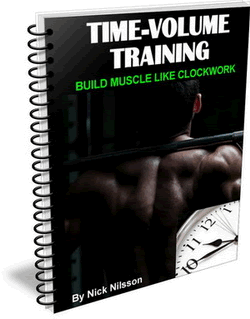When it comes to working the quads, there's nothing better than a good squat.
If your goal is ONLY working the quads and not much else in the lower body, you might turn to leg extensions.
But here's the problem...leg extensions can be trouble for your knees, especially if you already have bad knees or if you use a ballistic movement on the exercise (or too much range of motion). Clearly, the leg extension can really work the quads hard but sometimes the potential knee issues aren't a good trade-off.
So what do we do to work ONLY the quads then? The Braced Leg Squat (also known as a Spanish Squat when done with a band).
This exercise locks the lower legs into place during the squat movement. What this does is send the VAST majority of the tension of the exercise directly into the quads. It's almost like doing an inverse leg extension where instead of the thighs being locked down and the lower legs moving, the lower legs are locked down and the thighs are moving.
This exercise is done using only a bar and a power rack (and a barbell pad, if you've got one), which makes it a lot more accessible.
It's a great exercise and REALLY tough on the quads - if you like a good quad burn, this one will leave you on the floor.
|
How To Do The Braced Leg Squat:
The first thing you need to do is set up the bar in the rack. Set the safety rails of the rack near the bottom, probably about 18 inches off the floor. You'll have to experiment with heights to get the right spot for you.
I like to use a barbell pad on the bar for cushioning. A towel wrapped around the bar will work, if you don't have a pad available. Set that right in the center of the bar. Set the bar on the rails and brace it right up against the uprights of the rack. I'll explain the exercise without weight first but you can do it holding onto dumbbells as well.
It's CRITICAL that you have on shoes that grip well onto the floor for this exercise. Your feet aren't going to be braced on anything - only friction and muscle power is going to be holding them in position.
Step into the rack and set your feet right in front of the bar. Your upper calves (just below the knees) should be braced up against the barbell. Your heels should be pretty much right underneath the bar. Basically, your shins should NOT be vertical but at a bit of a forward leaning angle. This slight angle will help to lock your lower legs into the movement because instead of your feet being able to slide forward, the slight angle means they have to dig into the floor before they can slide forward - even that slight angle helps a lot.

Hold your arms either straight out in front of you or crossed across your chest - whichever you prefer.
Now sit down! Keep your torso vertical and drop back like you were doing a squat. Because your lower legs are locked into position, your knees will be the pivot point. It may sound like it could hurt the knees but in my experience there is a LOT LESS stress on the knees with this one than with leg extensions.

Go down until the tops of your thighs are parallel with the ground then, squeezing your quads hard, come back up all the way to the top. I like to come to full vertical and relax the quads for a moment to let some of the lactic acid dissipate. You can keep tension on by not coming all the way up but, believe me, there will be no shortage of lactic acid or tension even if you DO come all the way up.
At this point, you may find you need to readjust your foot position to get the best feel on the exercise - it's hard to get it exactly right on the first rep. So fix your foot position if you need to then sit back down and repeat.
To add resistance to this exercise, hold onto dumbbells, either in the goblet position or hanging at your sides.
Goblet Position



Hanging Position
I've also found using dumbbells makes for a great drop set - you literally drop the weight when you can't do any more reps with the dumbbells. At the bottom of the squat, just set the dumbbells down on the floor and keep going using only bodyweight.

When you start getting towards the last few reps that you can possibly do, you can also spot yourself by pushing yourself up on your thighs. It gives you a bit of help and allows you to keep going.
In addition, another method I like to use is to lock my hips into position and just use the quads to tip my body forward.


You'll find with this exercise that the lactic acid really starts cranking up. To flush it out, come to the top standing position and shake your quads a little - let some circulation help remove some of it. Then keep going.
And if you want another challenge, try dropping the safety rails down one more notch so that the bar hits a little lower on the calves. This allows you to sit even LOWER down into the squat because the bar or pad don't get in the way of your hamstrings as you sit down. Squat as far down as you can possibly go with this one - it's a great finisher.
Band Bracing - The Spanish Squat
If you don't have access to a squat rack for bracing the bar on like this, you can also use a stiff band to brace your legs. This is called a Spanish Squat.
This is my recommended source for training bands. (Note: Use Coupon Code "rbtfitstep" to get 10% off your purchase of a band package)



This exercise will BURN. It's an excellent one for finishing off the quads with laser focus, without resorting to Leg Extensions.
![]()
More From Fitstep.com
| How to Do Your First Chin-Up | |
| Shred Your Back and Chest With a Superset of In-Set Supersets | |
| Where Do I Start With Fitness? Start Here. | |
| Build Bigger Biceps FAST With This NEW Way To Do Incline Curls |
Share This Page...
---
Home -> Exercise Library -> Quadricep Exercises -> Braced Leg Squats



